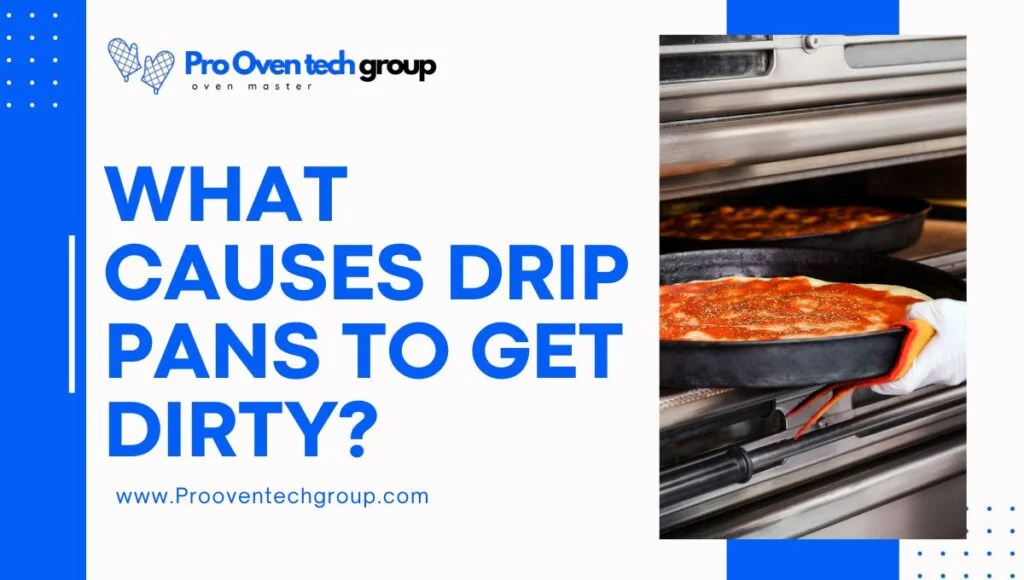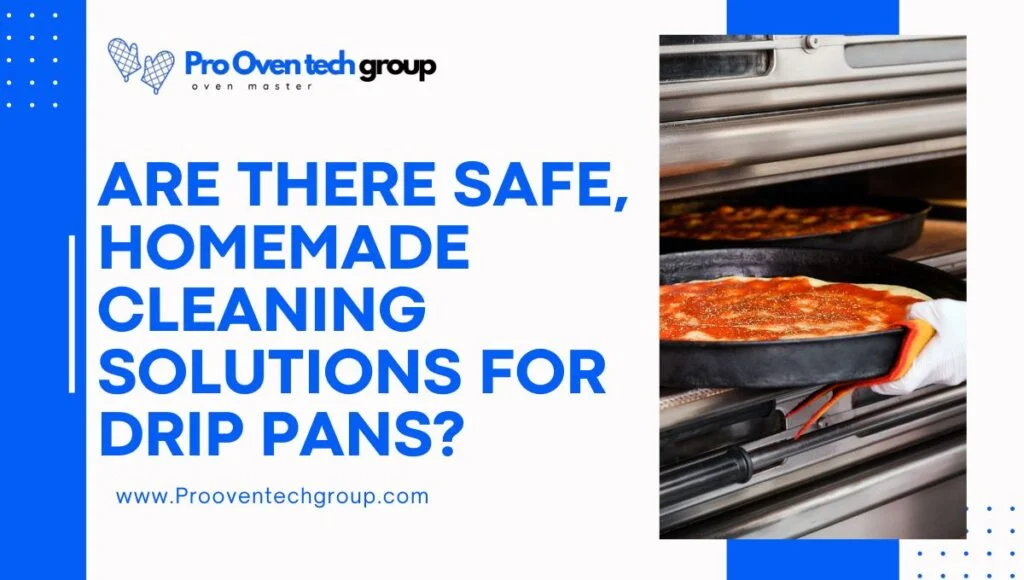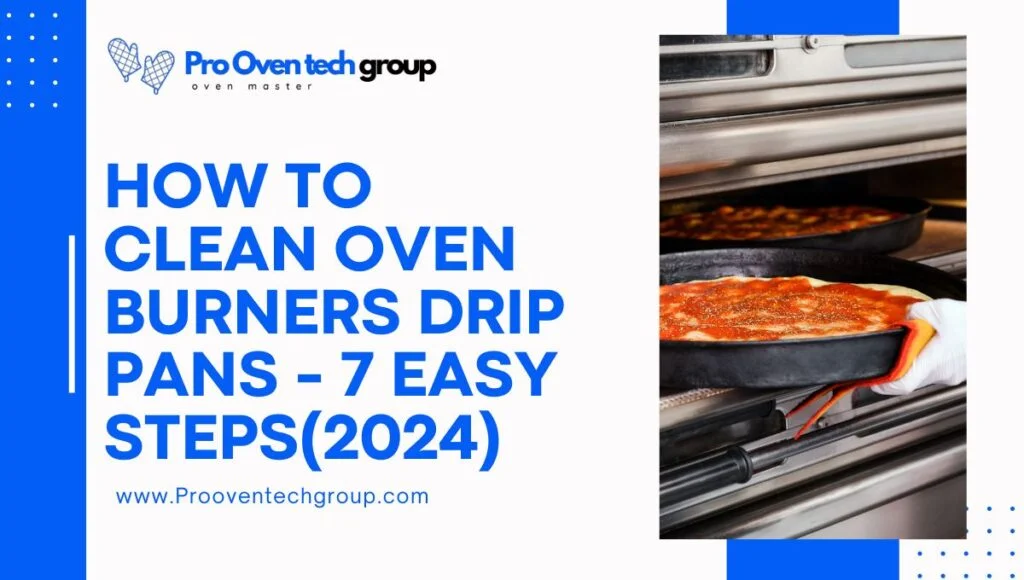How to clean oven burners drip pans? Keeping your oven’s burner drip pans clean is not only essential for maintaining a pristine kitchen but also for ensuring the efficiency and safety of your cooking appliances. Over time, these drip pans can accumulate spills, splatters, and burnt-on residue from daily cooking, which can become both unsightly and a potential fire hazard.
The key to tackling this greasy problem lies in a simple yet effective cleaning routine.
By regularly attending to your drip pans, you can significantly extend the lifespan of your oven, improve its performance, and contribute to a healthier cooking environment. Whether you’re dealing with just a light layer of grease or a stubborn build-up, the following steps will guide you through the process, making it less of a chore and more of a quick kitchen refresh activity.
Table of Contents
What causes drip pans to get dirty?

Drip pans get dirty primarily due to spills and splatters from cooking. Over time, even the smallest droplets of oils and sauces can accumulate, leading to burnt-on residues from the heat of the oven burner. Regular cooking, especially high-heat methods, accelerates this process.
Spills from Cooking
Every time you cook, there’s a chance that liquids or bits of food escape from your cookware. These can land directly on the drip pans, where they start to build up over time. Cleaning up spills right after cooking, when possible, helps minimize buildup.
High-Heat Cooking
Cooking at high temperatures can cause oils and fats to splatter more violently, reaching a wider area. These residues are more prone to burning onto the surface of the drip pans, making them harder to clean if not addressed quickly.
Frequent Use
The more you use your oven, the more opportunities there are for drip pans to collect debris. Regularly using your oven, especially for tasks like roasting and frying, can significantly contribute to the accumulation of grime on the pans.
These factors combine to make keeping drip pans clean a necessary part of kitchen maintenance. Regular cleaning can help manage these issues, making your cooking experiences both safer and more enjoyable.
How often should drip pans be cleaned?
The frequency of cleaning drip pans varies with use, but aiming for a thorough clean once a month is beneficial. Regular maintenance prevents buildup, ensures efficient appliance operation, and keeps your kitchen safe and inviting.
Based on Cooking Frequency
- Clean weekly if you use the oven daily.
- Bi-weekly cleaning is good for moderate oven users.
- Monthly cleaning suits those who rarely use ovens.
- More frequent cleaning may be needed for spills.
- Adjust the schedule based on seasonal cooking habits.
Type of Cooking
- High-heat cooking requires more frequent cleaning efforts.
- Roasting meats often? Clean drip pans afterward.
- Baking generally calls for less frequent cleaning.
- Fried foods mean more splatter and more cleanups.
- Vegetarian cooking typically results in less greasy buildup.
Seasonal Considerations
- Holiday cooking can increase the need for cleaning.
- Summer grilling reduces oven use and cleaning frequency.
- Winter comfort foods might mean more oven spills.
- Spring and fall deep cleaning includes the oven.
- Adjust cleaning frequency as your cooking habits change.
What materials are needed for cleaning drip pans?
- Dish Soap: A staple in any cleaning arsenal, dish soap is effective at breaking down grease and food residues. Simply mix with warm water for a gentle yet effective cleaning solution that’s safe for most surfaces.
- Baking Soda: Great for tackling tough, burnt-on messes, baking soda acts as a mild abrasive that can help remove stubborn stains without scratching your drip pans. Combine with water to make a paste for the best results.
- Vinegar: An all-natural cleaning powerhouse, vinegar helps dissolve grime and neutralize odors. Mixing vinegar with water creates a solution that’s excellent for soaking and loosening up the gunk in your drip pans.
- Scrubbing Brush or Pad: A non-abrasive scrubbing brush or pad is essential for physically removing the buildup without harming the surface of your drip pans. Soft sponges or dishcloths can also be effective for less severe cases.
- Paper Towels or Cleaning Cloths: After you’ve scrubbed away the dirt, you’ll need something absorbent to wipe away the residue and dry the drip pans. Paper towels or reusable cleaning cloths work perfectly for this final step.
What is the best method to clean drip pans?
The best method for cleaning oven burners’ drip pans involves a combination of soaking, scrubbing, and rinsing. This approach ensures that all types of grime, from light grease to burnt-on food, can be effectively removed, leaving your drip pans looking like new. Here’s a friendly, step-by-step guide to tackle this task:
1. Pre-Soak to Loosen Grime
- Fill your sink with hot water and add a squirt of dish soap.
- Submerge the drip pans in the soapy water.
- Allow them to soak for at least 30 minutes.
- This helps loosen the buildup, making it easier to scrub off.
2. Scrubbing the Tough Spots
- Mix baking soda with water to create a paste.
- Apply the paste directly to the stubborn spots.
- Use a non-abrasive scrubbing pad to gently scrub the areas.
- This method targets the toughest stains without scratching the pans.
3. Rinse Thoroughly
- After scrubbing, rinse the drip pans under warm running water.
- Make sure all soap and baking soda residues are washed away.
- Rinsing well ensures that no cleaning agent is left behind.
- Shake off excess water before drying.
4. Drying and Replacing
- Dry the drip pans completely with a clean towel or allow them to air dry.
- Once dry, check for any missed spots and touch up if necessary.
- Place the clean drip pans back under the burners.
- Enjoy cooking with your freshly cleaned oven components.
How can I prevent spillage on drip pans?
Preventing spillage on drip pans is key to maintaining a clean and efficient oven. Regular attentiveness and simple adjustments to cooking habits can significantly reduce the likelihood of spills and the subsequent cleaning effort required.
- Use larger pots and pans to contain splatters.
- Place foil under dishes to catch drips and spills.
- Opt for baking dishes with high sides for roasting.
- Pre-cook ingredients that might release water or fat.
- Utilize oven-safe bags for meats to contain juices.
- Cook at lower temperatures to reduce splatter potential.
- Check and stir food minimally to avoid spillage.
- Regularly inspect and adjust the positioning of cookware.
In essence, a combination of proactive measures and mindful cooking can drastically cut down on spillages, making oven maintenance smoother and your kitchen cleaner.
Are there safe, homemade cleaning solutions for drip pans?

- Lemon and Salt Scrub: Lemon’s natural acidity breaks down grease, while salt acts as a gentle abrasive. Together, they create a powerful, eco-friendly paste. Just sprinkle salt on the pans, squeeze lemon over it, mix, scrub, and rinse.
- Borax and Water Solution: Borax mixed with water forms a potent cleaning solution. It’s especially good for heavy-duty grime. Dissolve a few tablespoons of borax in hot water, soak the drip pans, scrub, and admire the shine.
- Hydrogen Peroxide and Baking Soda: This combo lifts even the most stubborn stains. Sprinkle baking soda on the pans, add hydrogen peroxide, wait for it to bubble, scrub gently, and rinse. It’s like magic for your drip pans.
- Vinegar and Baking Soda: For a fizzing, grime-fighting action, sprinkle baking soda on the pans, then spray with vinegar. After the fizzing stops, scrub and rinse. It’s a non-toxic way to achieve gleaming results.
- Cream of Tartar Paste: A lesser-known but effective cleaner, cream of tartar brightens metal. Make a paste with water, apply to the pans, leave it for a few minutes, scrub, and rinse. Your drip pans will look brand new.
Conclusion How to clean oven burners drip pans
In conclusion, keeping your oven’s drip pans clean is not only essential for maintaining the appearance and hygiene of your kitchen, but it also contributes to the efficiency and lifespan of your cooking appliances. By utilizing the simple, yet effective cleaning methods and homemade solutions outlined above, you can ensure that your drip pans remain in pristine condition without the need for harsh chemicals.
Ultimately, a bit of preventative care, combined with regular cleaning, can make a significant difference in the upkeep of your kitchen. Whether you opt for natural home remedies or traditional cleaning agents, the key is consistency and a bit of elbow grease.
FAQS
Q1. How to clean oven burners drip pans without?
A1. You can clean drip pans without using harsh chemicals by utilizing natural cleaning solutions like vinegar, lemon and salt scrub, borax and water solution, hydrogen peroxide and baking soda, or cream of tartar paste.
Q2. Cleaning stove drip pans with baking soda and vinegar?
A2. Yes, you can clean stove drip pans using baking soda and vinegar. Sprinkle baking soda on the pans, spray with vinegar, let it sit for a few minutes, scrub, and rinse. This method is safe and effective for removing stubborn stains.
Q3. How to clean oven burners drip pans with vinegar?
A3. To clean oven burners drip pans with vinegar, mix equal parts of water and vinegar in a spray bottle and generously spray the pans. Let it sit for a few minutes before scrubbing and rinsing. This method helps remove grime and grease from the pans.
Q4. How to clean oven burners drip pans with baking?
A4. You can use baking soda to clean oven burners drip pans by creating a paste with water and applying it directly on the pans. Let it sit for a few minutes, scrub gently, and rinse thoroughly. Baking soda is effective in removing tough stains without scratching the pans.
Q5. How to clean burnt drip pans?
A5. To clean burnt drip pans, soak them in hot soapy water for at least 30 minutes to loosen the buildup. Next, use a non-abrasive scrubbing pad to gently scrub the pans. For tougher stains, create a paste with baking soda and water and apply it directly on the burnt areas before scrubbing and rinsing thoroughly.

